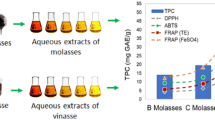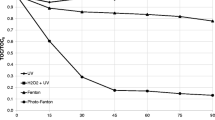Abstract
The mutagenic and genotoxic activity of vinasses collected from a fuel alcohol plant, located in the municipality of Frontino, Northwestern Colombia, were evaluated. Two samples obtained from an 82-L capacity hybrid reactor (UASB-anaerobic filter (AF)-UASB) were studied under laboratory conditions after being treated with biological oxidation, the first, and the second with Fenton reaction consecutively. Mutagenicity was evaluated in vitro by the Ames test using strains TA98 and TA100 with and without S9 metabolic activation. The genotoxic analysis was conducted using the Allium cepa roots assay where chromosomal aberrations were used as clastogenic or aneugenic response markers, and micronuclei as mutagenic response. The Ames test results showed a strain-dependent positive linear association with the vinasse sample concentration before treatment (dose–response effect). Unlike TA100, strain TA98 showed a mutagenic effect in both the presence and absence of metabolic enzymes. After the biological oxidation treatment, vinasse mutagenicity significantly decreased. Finally, after Fenton treatment, the sample did not induce any mutagenic event. Genotoxic activity was observed in all three samples, but there was a higher frequency in the vinasse sample before treatment. Concerning the frequency of micronuclei, no clear association was observed with either the concentration or the type of sample.



Similar content being viewed by others
References
Abdel Migid, H. M., Azab, Y. A., & Ibrahim, W. M. (2007). Use of plant genotoxicity bioassay for the evaluation of efficiency of algal biofilters in bioremediation of toxic industrial effluent. Ecotoxicology and Environmental Safety, 66, 57–64.
Acilan, C., Potter, D. M., & Saunders, W. S. (2007). DNA repair pathways involved in anaphase bridge formation. Genes, Chromosomes and Cancer, 46, 522–531.
Ames, B. N., McCann, J., & Yamasaki, E. (1975). Methods for detecting carcinogens and mutagens with the Salmonella/mammalian-microsome mutagenicity test. Mutation Research, 31, 347–363.
Beltrán de Heredia, J. (2005). Tratamiento de las aguas residuales de destilerías de vino mediante un proceso combinado delodos activos y oxidación química. Alimentación Equipos Y Tecnología, 198, 55–59.
Beltrán, F. J., García-Araya, J. F., & Álvarez, P. M. (1999). Wine distillery wastewater degradation. 2. Improvement of aerobic biodegradation by means of an integrated chemical (ozone)-biological treatment. Journal of Agricultural and Food Chemistry, 47, 3919–3924.
Castegnaro, M., De Méo, M., Laget, M., Michelon, J., Garren, L., Sportouch, M. H., & Hansel, S. (1997). Chemical degradation of wastes of antineoplastic agents. 2: Six anthracyclines: idarubicin, doxorubicin, epirubicin, pirarubicin, aclarubicin, and daunorubicin. International Archives of Occupational and Environmental Health, 70, 378–384.
Chandra, R., Bharagava, R. N., & Rai, V. (2008). Melanoidins as major colourant in sugarcane molasses based distillery effluent and its degradation. Bioresource Technology, 99, 4648–4660.
Christofoletti, A., Pedro-Escher, J., & Fontanetti, C. (2013a). Assessment of the Genotoxicity of Two Agricultural Residues After Processing by Diplopods Using the Allium cepa Assay. Water, Air, & Soil Pollution, 224, 1523–1537.
Christofoletti, C. A., Escher, J. P., Correia, J. E., Marinho, J. F., & Fontanetti, C. S. (2013b). Sugarcane vinasse: environmental implications of its use. Waste Management, 33, 2752–2761.
Corvi, R., Albertini, S., Hartung, T., Hoffmann, S., Maurici, D., Pfuhler, S., van Benthem, J., & Vanparys, P. (2008). ECVAM retrospective validation of in vitro micronucleus test (MNT). Mutagenesis, 23, 271–283.
Dash, S., Panda, K. K., & Panda, B. B. (1988). Biomonitoring of low levels of mercurial derivatives in water and soil by Allium micronucleus assay. Mutation Research/Environmental Mutagenesis and Related Subjects, 203, 11–21.
de Heredia, J. B., Dominguez, J., & Partido, E. (2005). Physico-chemical treatment for the depuration of wine distillery wastewaters(vinasses). Sustainable Viticulture and Winery Wastes Management, 51, 159–166.
El-Shahaby, O., Migid, H. M. A., Soliman, M., & Mashaly, I. (2003). Genotoxicity screening of industrial wastewater using the Allium chromosome aberration assay. Pakistan Journal of Biological Sciences, 6, 23–28.
Fernandes, T., Mazzeo, D., & Marin-Morales, M. (2007). Mechanism of micronuclei formation in polyploidizated cells of Allium cepa exposed to triXuralin herbicide. Pesticide Biochemistry and Physiology, 88, 252–259.
Grant, W., Lee, H., Logan, D., & Salamone, M. (1992). The use of Tradescantia and Vicia faba bioassays for the in situ detection of mutagens in an aquatic environment. Mutation Research, 270, 53–64.
Hansel, S., Castegnaro, M., Sportouch, M. H., De Méo, M., Milhavet, J. C., Laget, M., & Duménil, G. (1997). Chemical degradation of wastes of antineoplastic agents: cyclophosphamide, ifosfamide and melphalan. International Archives of Occupational and Environmental Health, 69, 109–114.
Kitts, D. D., Wu, C. H., Stich, H. F., & Powrie, W. D. (1993). Effect of glucose-lysine Maillard reaction products on bacterial and mammalian cell mutagenesis. Journal of Agricultural and Food Chemistry, 41, 2353–2358.
Leme, D. M., & Marin-Morales, M. A. (2008). Chromosome aberration and micronucleus frequencies in Allium cepa cells exposed to petroleum polluted water–A case study. Mutation Research/Genetic Toxicology and Environmental Mutagenesis, 650, 80–86.
Leme, D. M., & Marin-Morales, M. A. (2009). Allium cepa test in environmental monitoring: a review on its application. Mutation Research/Reviews in Mutation Research, 682, 71–81.
Ma, T. H., Xu, Z., Xu, C., McConnell, H., Rabago, E. V., Arreola, G. A., & Zhang, H. (1995). The improved Allium/Vicia root tip micronucleus assay for clastogenicity of environmental pollutants. Mutation Research, 334, 185–195.
Maertens, R., Bailey, J., & White, P. (2004). The mutagenic hazards of settled house dust: a review. Mutation Research-Reviews in Mutation Research, 567, 401–425.
Mahadevan, B., Lucha, A., Atkin, J., Nguyena, T., Sharma, A., Aminc, S., & Baird, W. (2006). Investigation of the genotoxicity of dibenzo[c, p]chrysene in human carcinoma MCF-7 cells in culture. Chemico-Biological Interactions, 164, 181–191.
Maluszynska, J., & Juchimiuk, J. (2005). Plant genotoxicity: a molecular cytogenetic approach in plant bioassays. Arhiv za Higijenu Rada i Toksikologiju, 56, 177–184.
Maron, D., & Ames, B. (1983). Revised methods for the Salmonella mutagenicity test. Mutation Research, 113, 173–215.
Matilainen, A., & Sillanpää, M. (2010). Removal of natural organic matter from drinking water by advanced oxidation processes. Chemosphere, 80, 351–365.
Mohana, S., Acharya, B. K., & Madamwar, D. (2009). Distillery spent wash: Treatment technologies and potential applications. Journal of Hazardous Materials, 163, 12–25.
Murray, A. W., & Kirschner, M. W. (1989). Dominoes and clocks: the union of two views of the cell cycle. Science, 246, 614–621.
Nandy, T., Shastry, S., & Kaul, S. (2002). Wastewater management in a cane molasses distillery involving bioresource recovery. Journal of Environmental Management, 65, 25–38.
Novelo, R. I. M., Reyes, R. B. G., Borges, E. R. C., & Riancho, M. R. S. (2010). Tratamiento de lixiviados por oxidación Fenton. Ingeniería e Investigación, 30, 80–85.
Ohmomo, S., Daengsubha, W., Yoshikawa, H., Yui, M., Nozaki, K., Nakajima, T., & Nakamura, I. (1988). Screening of anaerobic bacteria with the ability to decolorize molasses melanoidin (microbiology & fermentation industry). Agricultural and Biological Chemistry, 52, 2429–2435.
Oñate, J. F., & Paruma, A. F. (2007). Potencialidad Mutagénica y Genotóxica de Afluentes de una Planta de Potabilización del Suroccidente de Medellín (planta “A”). Popayán: Universidad del Cauca.
Pala, A., & Erden, G. (2005). Decolorization of a baker's yeast industry effluent by Fenton oxidation. Journal of Hazardous Materials, 127, 141–148.
Parnaudeau, V., Condom, N., Oliver, R., Cazevieille, P., & Recous, S. (2008). Vinasse organic matter quality and mineralization potential, as influenced by raw material, fermentation and concentration processes. Bioresource Technology, 99, 1553–1562.
Radic, S., Stipanicev, D., Vujcic, V., Rajcic, M. M., Sirac, S., & Pevalek-Kozlina, B. (2010). The evaluation of surface and wastewater genotoxicity using the Allium cepa test. Science of the Total Environment, 408, 1228–1233.
Raghukumar, C., Mohandass, C., Kamat, S., & Shailaja, M. (2004). Simultaneous detoxification and decolorization of molasses spent wash by the immobilized white-rot fungus Flavodon flavus isolated from a marine habitat. Enzyme and Microbial Technology, 35, 197–202.
Rustenbil, J., & Poortvliet, T. (1992). Copper and zinc in estuarine water: chemical speciation in relation to bioavailability to the marine planktonic diatom Ditylum brightwellii. Environmental Toxicology and Chemistry, 11, 1615–1625.
Satyawali, Y., & Balakrishnan, M. (2008). Wastewater treatment in molasses-based alcohol distilleries for COD and color removal: a review. Journal of Environmental Management, 86, 481–497.
Seth, C., Misra, V., Chauhan, L., & Singh, R. (2008). Genotoxicity of cadmium on root meristem cells of Allium cepa: cytogenetic and Comet assay approach. Ecotoxicology and Environmental Safety, 71, 711–716.
Srivastava, S., & Jain, R. (2010). Effect of distillery spent wash on cytomorphological behaviour of sugarcane settlings. Journal of Environmental Biology, 31(5), 809–812.
Vargas, V. M. F., Guidobono, R. R., Jordão, C., & Henriques, J. A. P. (1995). Use of two short-term tests to evaluate the genotoxicity of river water treated with different concentration/extraction procedures. Mutation Research/Genetic Toxicology, 343, 31–52.
Vargas, V. M. F., Miglivaca, S. B., Melo, A. C., Horn, R. C., Guidobono, R. R., Sa Ferreira, I. C. F., & Pestana, M. H. D. (2001). Genotoxicity assessment in aquatic environments under the influence of heavy metal and organic contaminants. Mutation Research, 490, 141–158.
Wolmarans, B., & De Villiers, G. H. (2004). Start-up of a UASB effluent treatment plant on distillery wastewater. Water SA, 28, 63–68.
Yessilada, E. (1999). Genotoxic activity of vinasse and its effect on fecundity and longevity of Drosophila melanogaster. Bulletin of Environmental Contamination and Toxicology, 63, 560–566.
Yildiz, M., Ciğerci, I. H., Konuk, M., Fidan, A. F., & Terzi, H. (2009). Determination of genotoxic effects of copper sulphate and cobalt chloride in Allium cepa root cells by chromosome aberration and comet assays. Chemosphere, 75, 934–938.
Zuleta, M., Uribe, Y., Valencia, C., Vargas, H., Orozco, L. Y., & Lopez, C. (2004). Contribución de la contaminación y cloración en la Mutagénicidad, genotoxicidad y presencia de mutágenos en agua potable. Actualités Biologiques, 26, 125–136.
Acknowledgments
We would like to thank the Ministry of Agriculture of Colombia and the Strategy of Groups Sustenance 2011–2012 of the University of Antioquia for financial support of this research.
Author information
Authors and Affiliations
Corresponding author
Rights and permissions
About this article
Cite this article
Oñate, J., Arenas, A., Ruiz, A. et al. Evaluation of Mutagenic and Genotoxic Activity in Vinasses Subjected to Different Treatments. Water Air Soil Pollut 226, 144 (2015). https://doi.org/10.1007/s11270-014-2250-0
Received:
Accepted:
Published:
DOI: https://doi.org/10.1007/s11270-014-2250-0




